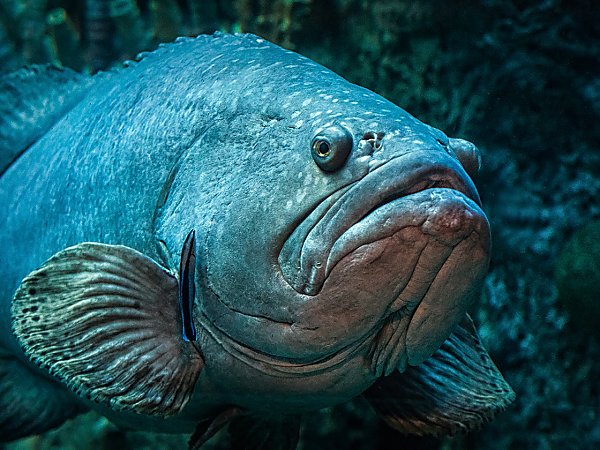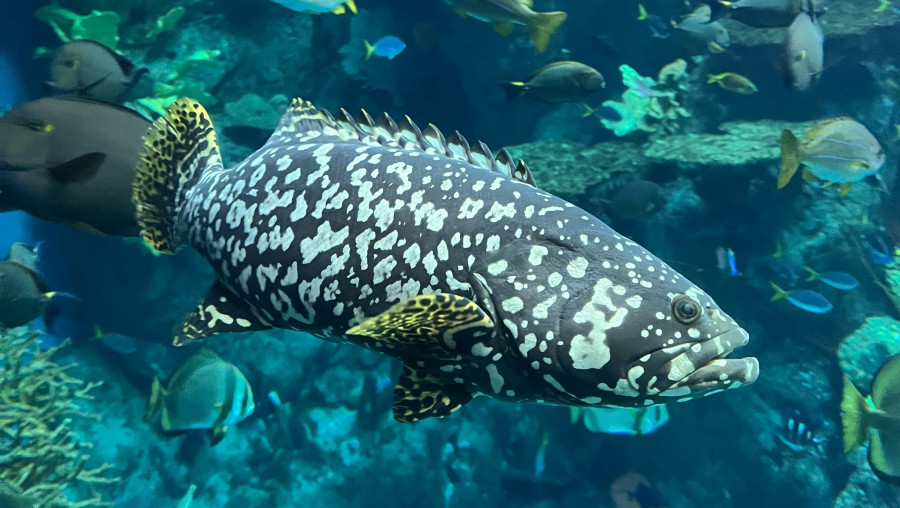Queensland Grouper
Epinephelus lanceolatus
The Queensland grouper is the world’s largest reef-dwelling bony fish. Adults have mottled brown to dark grey stocky bodies. They are often found either hovering in midwater or resting motionless on the substrate. A very shy fish, the larger they grow, the shyer they become. Not much is known about its spawning activity or longevity. This speciesound in the Indo-Pacific and is listed as Vulnerable by the International Union for Conservation of Nature (IUCN).

Credit: Robin Riggs

Credit: Aquarium of the Pacific/Celeste Moen
SPECIES IN DETAIL
Queensland Grouper
Epinephelus lanceolatus
CONSERVATION STATUS: Vulnerable
CLIMATE CHANGE: Not Applicable
At the Aquarium
The Queensland Grouper resides in the Tropical Reef Habitat in the Tropical Pacific Gallery.
Geographic Distribution
Queensland groupers live in the Indo-Pacific Ocean, from the Hawaiian and Pitcairn Islands, southwest to Australia, north to southern Japan, west to the Red Sea, and south to Algoa Bay, South Africa.
Habitat
This large fish is commonly found in shallow waters in or around coral reefs. It is also found in shipwrecks or caves and estuaries.
Physical Characteristics
Adults are mottled brown to dark grey in color, with pale spots or blotches on their body and numerous black spots on their fins. Juveniles have irregular yellow and black markings. This fish has a robust body with a rounded tail and fleshy lips. Dorsal fin spines of mature individuals increase in size front to back. Mature adults can weigh up to 882 pounds (400 kg). Large individuals are possibly ciguatoxic.
Size
The Queensland grouper grows to a max length of 8.9 feet (2.7 meters). On average, this fish species grows to around 6 feet (1.8 meters).
Diet
Queensland groupers feed on fishes, including batoids and small sharks, spiny lobsters, crustaceans and juvenile sea turtles.
Reproduction
Not much is known about the reproduction of this species. It is believed that spawning takes place in the summer months, with the female releasing her eggs into the water to be fertilized by the male’s release of sperm.
Behavior
The Queensland grouper is a solitary, slow-moving fish usually found resting motionless on the substrate or hovering midwater.
Adaptation
With its mottled coloration the Queensland grouper is well camouflaged.
Longevity
This is believed to be a long-lived fish but the actual lifespan is unknown.
Conservation
This species is listed as Vulnerable by IUCN due to overfishing. Many people consider it delicious. In parts of Asia this fish is highly valued and considered to have medicinal value and to bring good luck.
SPECIES IN DETAIL | Print full entry
Queensland Grouper
Epinephelus lanceolatus
CONSERVATION STATUS: Vulnerable
CLIMATE CHANGE: Not Applicable
The Queensland Grouper resides in the Tropical Reef Habitat in the Tropical Pacific Gallery.
Queensland groupers live in the Indo-Pacific Ocean, from the Hawaiian and Pitcairn Islands, southwest to Australia, north to southern Japan, west to the Red Sea, and south to Algoa Bay, South Africa.
This large fish is commonly found in shallow waters in or around coral reefs. It is also found in shipwrecks or caves and estuaries.
Adults are mottled brown to dark grey in color, with pale spots or blotches on their body and numerous black spots on their fins. Juveniles have irregular yellow and black markings. This fish has a robust body with a rounded tail and fleshy lips. Dorsal fin spines of mature individuals increase in size front to back. Mature adults can weigh up to 882 pounds (400 kg). Large individuals are possibly ciguatoxic.
The Queensland grouper grows to a max length of 8.9 feet (2.7 meters). On average, this fish species grows to around 6 feet (1.8 meters).
Queensland groupers feed on fishes, including batoids and small sharks, spiny lobsters, crustaceans and juvenile sea turtles.
Not much is known about the reproduction of this species. It is believed that spawning takes place in the summer months, with the female releasing her eggs into the water to be fertilized by the male’s release of sperm.
The Queensland grouper is a solitary, slow-moving fish usually found resting motionless on the substrate or hovering midwater.
With its mottled coloration the Queensland grouper is well camouflaged.
This is believed to be a long-lived fish but the actual lifespan is unknown.
This species is listed as Vulnerable by IUCN due to overfishing. Many people consider it delicious. In parts of Asia this fish is highly valued and considered to have medicinal value and to bring good luck.

